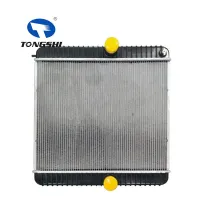Dec. 18, 2023
Automobiles & Motorcycles
In the realm of heavy-duty trucks, where engines are powerhouses and demands on cooling systems are rigorous, the role of the radiator is pivotal. A heavy-duty truck radiator is not just a component; it's a critical element in maintaining the engine's temperature, ensuring optimal performance, and extending the life of the entire vehicle. Let's delve into the specifics of heavy-duty truck radiators, their functions, common challenges, and the importance of regular maintenance.
**1. The Crucial Role of Radiators in Heavy-Duty Trucks:
Heat Dissipation:
Heavy-duty trucks operate under strenuous conditions, generating substantial heat. The radiator's primary function is to dissipate this heat, preventing the engine from reaching temperatures that could lead to inefficiencies or damage.
Coolant Circulation:
The radiator facilitates the circulation of coolant through the engine. As the coolant absorbs heat from the engine, it travels to the radiator, where it releases the heat to the surrounding air, effectively regulating the engine's temperature.
**2. Key Components of Heavy-Duty Truck Radiators:
Core:
The core is the heart of the vehicle radiator, typically made of aluminum or copper. It consists of tubes and fins that maximize the surface area for heat exchange. The coolant flows through the tubes, and the fins disperse the heat.
Tanks:
Radiator tanks house the coolant and provide a connection point for hoses. They are usually located on the top and bottom of the core and are critical in maintaining proper coolant levels.
Fan and Shroud:
Heavy-duty trucks often employ a fan and shroud assembly to enhance cooling efficiency. The fan helps draw air through the radiator, while the shroud ensures that air is directed effectively across the entire surface.

Inlet and Outlet:
The inlet and outlet are ports through which coolant enters and exits the radiator. Proper alignment and sealing of these connections are crucial for the radiator's effectiveness.
**3. Challenges Faced by Heavy-Duty Truck Radiators:
Overheating:
Overheating is a significant concern for heavy-duty truck radiators, especially when vehicles operate in extreme conditions or carry heavy loads. Insufficient cooling can lead to engine damage and decreased performance.
Corrosion:
Heavy-duty trucks are often exposed to harsh environments, and radiator cores can be susceptible to corrosion. This can compromise the efficiency of heat exchange and lead to leaks.
Clogging:
Accumulation of debris, minerals, or contaminants in the radiator can result in clogging, hindering the flow of coolant. Regular maintenance is crucial to preventing this issue.
**4. Importance of Regular Maintenance:
Inspections:
Regular inspections of the radiator, hoses, and connections are essential. Detecting and addressing issues early can prevent more significant problems down the road.
Coolant Levels and Quality:
Maintaining proper coolant levels and ensuring that the coolant is of the right quality is vital. Coolant serves not only as a heat transfer medium but also as a corrosion inhibitor.
Cleaning:
Periodic cleaning of the radiator's exterior is necessary to remove dirt, bugs, and debris that can impede airflow. This simple step can significantly enhance cooling efficiency.
Pressure Tests:
Conducting pressure tests on the radiator helps identify leaks or weak points. Addressing these issues promptly prevents coolant loss and maintains the radiator's effectiveness.
**5. Choosing the Right Radiator for Heavy-Duty Trucks:
Material:
When selecting a radiator, consider the material of the core. Aluminum radiators are lightweight and offer efficient heat transfer, while copper radiators are known for durability. The choice may depend on the specific needs of the truck.
Design and Size:
The design and size of the radiator should align with the truck's cooling requirements. Trucks with higher horsepower or those frequently operating in extreme conditions may benefit from larger or custom-designed radiators.
OEM vs. Aftermarket:
Original equipment manufacturer (OEM) radiators are specifically designed for the truck's make and model. Aftermarket options may provide cost savings but ensure compatibility and quality.
**6. Conclusion:
In the world of heavy-duty trucks, radiators are unsung heroes, silently working to ensure engines operate at optimal temperatures. Recognizing the importance of this component, understanding its key elements, and prioritizing regular maintenance are crucial steps toward preserving the longevity and efficiency of heavy-duty truck radiators. Whether navigating challenging terrains or hauling heavy loads, a well-maintained radiator is the silent guardian that contributes to a heavy-duty truck's resilience and performance.
Previous: User Installing and Securing Car Mats: Step-by-Step Guide
Next: Understanding the Basics of Control Systems Engineering
Related Articles
If you are interested in sending in a Guest Blogger Submission,welcome to write for us!
All Comments ( 0 )